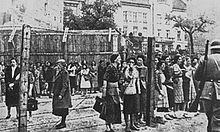The Yad Vashem Encyclopedia of the Ghettos During the Holocaust

The Yad Vashem Encyclopedia of the Ghettos During the Holocaust (האנציקלופדיה של הגטאות) is an encyclopedia compiled by the International Institute for Holocaust Research at Yad Vashem, under the editorship of Dan Michman. It represents ongoing research on all the Jewish ghettos that existed during the Holocaust. The encyclopedia was first published in English in two volumes in 2009, edited by Guy Miron and Shlomit Shulhani, with the support of the Claims Conference, and contained 1,100 entries. On International Holocaust Remembrance Day, January 27, 2013, the Hebrew version of the encyclopedia was launched on the internet.[1][2]
Motivation[edit]
Most of the academic research, both at Yad Vashem and in other institutions, has mainly focused on the history of the larger and more well-known ghettos (Warsaw Ghetto, Vilna Ghetto, Lodz Ghetto, Theresienstadt Ghetto etc.). This is despite the fact that more than 1,000 smaller ghettos have never been systematically researched academically (as opposed to memorial books and personal diaries).[3]
The purpose of creating the encyclopedia, which began in 2003, was to conduct systematic research and documentation on all the ghettos across Europe, an ongoing work that did not end with the publication of the encyclopedia. Therefore, it was decided to publish it continuously and update it regularly on the internet, and to open it, in addition to being a tool for researchers, also for free public access, including for survivors' families and the younger generation.
Sources of the Encyclopedia and Its Scope[edit]
The encyclopedia is based on the compilation of materials systematically collected from research, testimonies, documents, and historical information about more than 1,100 ghettos, mainly in Eastern Europe. One of the methodological problems in developing the encyclopedia was that there is no precise definition of a "ghetto" in practice. Therefore, it was decided to rely on phenomenology (a set of common characteristics, the coexistence of which indicates the concept, which is not based on prior theoretical consideration of the term, nor on the way the Nazis used it) through the analysis of historical materials. While some ghettos, mainly in the areas conquered by Operation Barbarossa, existed for only a few weeks or months before their liquidation and the deportation of their prisoners to extermination, in Poland and Lithuania there were ghettos that operated for years. In many of the smaller ghettos that existed for a short time, no survivors remained, and information about their existence was collected and pieced together from personal letters and other documents. Much of this material was for years the property of archives in the Soviet Union, which were closed to Western researchers, and a significant portion of it was lost or damaged over time.[4]
The editors of the encyclopedia note that a significant portion of the material is based on direct testimonies of survivors, as compiled in the Encyclopedia of Jewish Communities published by Yad Vashem, and that an attempt was made to verify this information by cross-checking it with other research material to the extent possible, but by the nature of things and the time that has passed, not all information can be verified.
The information in each entry includes quantitative and chronological data, a description of living conditions, details of the Jewish leadership (Judenrat, if any, etc.) and the ways individuals coped. The encyclopedia is organized with numerous cross-references both within it (to other ghettos) and to the general research (personal names and topics).
Organization of the Entries[edit]
Each entry includes the location of the ghetto, including coordinates, and all the names by which it was known during the war.
To the extent possible, based on the amount of research material, the larger ghettos have sufficient chapters on the following topics: the period before World War II, the Soviet occupation (according to the Ribbentrop-Molotov Pact), the Nazi occupation, the establishment of the ghetto, the institutions of the ghetto and daily life, acts of murder and Aktionen, underground and resistance, and the number of survivors.
The entries are also accompanied by photographs, maps, documents, and a DVD with documentary films, which are included in the English edition.
This refers to the fact that the Nazis did not have a clear and consistent definition of what constituted a "ghetto", and the term was applied to a range of Jewish residential areas with varying degrees of restrictions and isolation.
References[edit]
- ^ "The Yad Vashem Encyclopedia of the Ghettos During the Holocaust". Yad Vashem Store. Retrieved 2024-04-16.
- ^ Miron, Gai; Shulhani, Shlomit (2009). The Yad Vashem Encyclopedia of the Ghettos During the Holocaust. NYU Press. ISBN 978-965-308-345-5.
- ^ אדרת, עופר (2013-01-25). "סיפורו של הגטו שמעל למחלבה". הארץ (in Hebrew). Retrieved 2024-04-16.
- ^ "האנציקלופדיה של הגטאות תעלה לרשת". www.makorrishon.co.il. Retrieved 2024-04-16.
